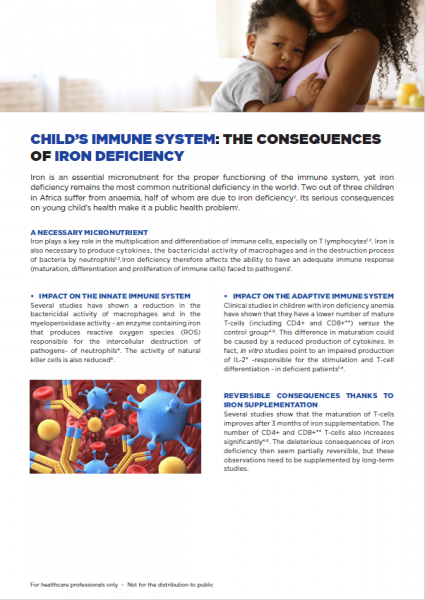Iron is an essential micronutrient for the proper functioning of the immune system, yet iron deficiency remains the most common nutritional deficiency in the world1. Two out of three children in Africa suffer from anaemia, half of whom are due to iron deficiency2. Its serious consequences on young child’s health make it a public health problem1.
A NECESSARY MICRONUTRIENT
Iron plays a key role in the multiplication and differentiation of immune cells, especially on T lymphocytes 1.3. Iron is also necessary to produce cytokines, the bactericidal activity of macrophages and in the destruction process of bacteria by neutrophils1.3. Iron deficiency therefore affects the ability to have an adequate immune response (maturation, differentiation and proliferation of immune cells) faced to pathogens1.
- IMPACT ON THE INNATE IMMUNE SYSTEM
Several studies have shown a reduction in the bactericidal activity of macrophages and in the myeloperoxidase activity – an enzyme containing iron that produces reactive oxygen species (ROS) responsible for the intercellular destruction of pathogens- of neutrophils4. The activity of natural killer cells is also reduced5.
- IMPACT ON THE ADAPTIVE IMMUNE SYSTEM
Clinical studies in children with iron deficiency anemia have shown that they have a lower number of mature T-cells (including CD4+ and CD8+**) versus the control group4.6. This difference in maturation could be caused by a reduced production of cytokines. In fact, in vitro studies point to an impaired production of IL-2* -responsible for the stimulation and T-cell differentiation – in deficient patients1.4.
REVERSIBLE CONSEQUENCES THANKS TO IRON SUPPLEMENTATION
Several studies show that the maturation of T-cells improves after 3 months of iron supplementation. The number of CD4+ and CD8+** T-cells also increases significantly4.6. The deleterious consequences of iron deficiency then seem partially reversible, but these observations need to be supplemented by long-term studies.
HOW CAN IRON DEFICIENCY BE PREVENTED?
In breastfed infants from 0 to 6 months, iron requirements are covered by fetal reserves and breast milk7. For non-breastfed infants, 200 ml per day of iron-fortified infant formula (0,6mg/100mL) is enough to meet the recommended needs for absorbed iron, which are 0.20mg/d8. But after 6 months, these needs raise to 1.1mg/d and it takes at least 800 ml per day of follow-on formula enriched with iron (0,9mg/100mL) to cover them8.
In breastfed and non-breastfed children, iron needs can be supplemented by diet from the beginning of diversification, at the age of 6 months8. Thus, a balanced intake of well-absorbed iron and coupled with vitamin C (to increase iron absorption) helps prevent iron deficiency and its harmful consequences on the child’s health.
Well-absorbed iron-rich foods8:
- Meat (especially red meat)
- Fish
- Fortified infants formulas and growing-up milks
- Enriched cereals

Publication : Child’s immune system : the consequences of iron deficiency
References
*IL-2: Interleukin 2
**CD4+ and CD8+: clusters of differentiation 4 and 8
- Hassan, Tamer Hasan, et al. “Impact of iron deficiency anemia on the function of the immune system in children.” Medicine 95.47 (2016).
- “The global prevalence of anaemia in 2011.” The global prevalence of anaemia in 2011 (p. 11) (2015).
- Maggini, Silvia, et al. “Selected vitamins and trace elements support immune function by strengthening epithelial barriers and cellular and humoral immune responses.” British Journal of Nutrition 98.S1 (2007): S29-S35.
- Attia, Mohamed Attia, et al. “Effect of iron deficiency anemia and its treatment on cell mediated immunity.” Indian Journal of Hematology and Blood Transfusion 25.2 (2009): 70-77.
- Spear AT and Sherman AR “Iron deficiency alters DMBA-induced tumor burden and natural killer cell cytotoxicityrats”. J Nutr 122:46–55 (1992)
- Aly, Sanaa S., et al. “Assessment of peripheral blood lymphocyte subsets in children with iron deficiency anemia.” BMC pediatrics 18.1 (2018): 49.
- Lapillonne, A., and O. Becquet. “Recommandations pour les apports en fer pendant les six premiers mois de vie.” Archives de Pédiatrie 24.5 (2017): 5S40-5S44.
- Tounian, P., and J-P. “Fer et nutrition.” Archives de Pédiatrie 24.5 (2017): 5S23-5S31.
BA20-368
